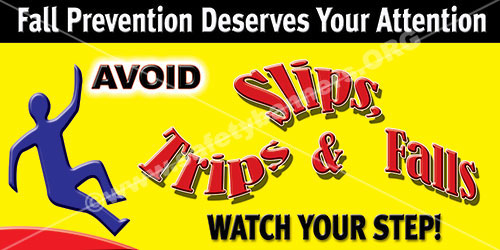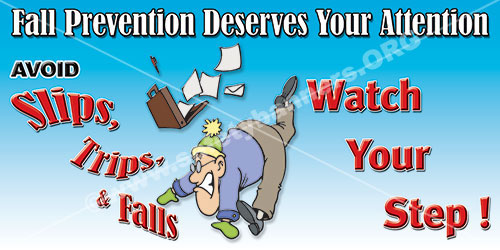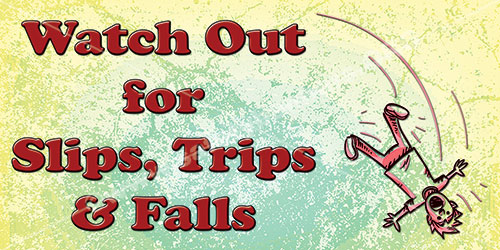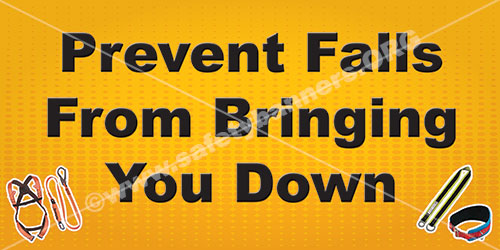Your Industrial Sign Shop
CLICK HERE for our NEW safety store, Safety Banners USA (safetybannersUSA.com)
Need a Custom Sign - We Can Do It.
We do a wide variety of custom signs for industry. PLUS, we do FREE custom sign design. Call us at 901-759-0932 or email us using the email button at the top center. We can probably do a sign exactly like you want.
We are not just America's largest Safety Banner manufacturer. We can do signs and banners for an amazing variety of needs.
Here are some example of signs we can do for you:
• Of course banners for any occasion
• Magnetic signs
• Aluminum signs
• Corrugated Plastic signs
• PVC Plastic signs
• Yard Signs
• Wall and Mural Graphics
• Pedestrian Area Foor Graphics
• And More
Need a sign solution? Call us at 901-759-0932, Central Time or email us using the button top center.
SafetyBanners.Org
1657 Shelby Oaks Drive N.
Memphis, TN 38134
Serving American industry since 1995
Safety banners for Slips, Trips and Falls for American industry.
Safety Banners built in Memphis, Tennesseee USA.
Our Slips, Trips and Falls Safety Banners are used by most of the Fortune 500 companies!
 Slips, Trips and Falls are a serious problem in American industry! Safety Banners can help!!
Slips, Trips and Falls are a serious problem in American industry! Safety Banners can help!!
Safety Banners for Slips, trips and falls help awareness of potential hazards:
Employee exposure to wet floors or spills and clutter that can lead to slips/trips/falls and other possible injuries.
Possible Solutions
Keep floors clean and dry In addition to being a slip hazard, continually wet surfaces promote the growth of mold, fungi, and bacteria, that can cause infections.
CLICK HERE for our NEW safety store, Safety Banners USA (safetybannersUSA.com)
Provide warning signs for wet floor areas.
 Where wet processes are used, maintain drainage and provide false floors, platforms, mats, or other dry standing places where practicable, or provide appropriate waterproof footgear.
Where wet processes are used, maintain drainage and provide false floors, platforms, mats, or other dry standing places where practicable, or provide appropriate waterproof footgear.
Walking/Working Surfaces Standard requires: Keep all places of employment clean and orderly and in a sanitary condition.
Keep aisles and passageways clear and in good repair, with no obstruction across or in aisles that could create a hazard. Provide floor plugs for equipment, so power cords need not run across pathways.
Keep exits free from obstruction. Access to exits must remain clear of obstructions at all times.
 It’s probably happened to most of us. That momentary lapse of inattention thinking about a personal problem or distracted by an activity that ends in a slip, trip or fall. A stumble down a stairway. A trip over an uneven surface. Slipping on the ice. It can lead to a variety of regrettable events ranging from a simple bruised shin to an extremely serious injury. It’s just one of a variety of conditions and situations that set the stage for slips, trips and falls in the workplace.
It’s probably happened to most of us. That momentary lapse of inattention thinking about a personal problem or distracted by an activity that ends in a slip, trip or fall. A stumble down a stairway. A trip over an uneven surface. Slipping on the ice. It can lead to a variety of regrettable events ranging from a simple bruised shin to an extremely serious injury. It’s just one of a variety of conditions and situations that set the stage for slips, trips and falls in the workplace.
According to the U.S. Department of Labor, slips, trips and falls make up the majority of general industry accidents, which account for:
15 percent of all accidental deaths per year, the second-leading cause behind motor vehicles
 About 25 percent of all reported injury claims per fiscal year
About 25 percent of all reported injury claims per fiscal year
More than 95 million lost work days per year – about 65 percent of all work days lost
In general, slips and trips occur due to a loss of traction between the shoe and the walking surface or an inadvertent contact with a fixed or moveable object which may lead to a fall. There are a variety of situations that may cause slips, trips and falls.
Wet or greasy floors
Dry floors with wood dust or powder
Uneven walking surfaces
 Polished or freshly waxed floors
Polished or freshly waxed floors
Loose flooring, carpeting or mats
Transition from one floor type to another
Missing or uneven floor tiles and bricks
Damaged or irregular steps; no handrails
Sloped walking surfaces
Shoes with wet, muddy, greasy or oily soles
Clutter
Electrical cords or cables
Open desk or file cabinet drawers
Damaged ladder steps
Ramps and gang planks without skid-resistant surfaces
Metal surfaces – dock plates, construction plates
Weather hazards – rain, sleet, ice, snow, hail, frost
Wet leaves or pine needles
SafetyBanners.Org
1657 Shelby Oaks Drive N.
Memphis, TN 38134
Serving American industry since 1995